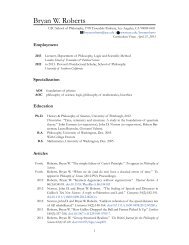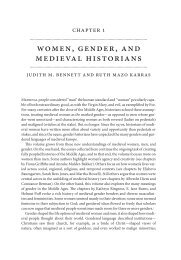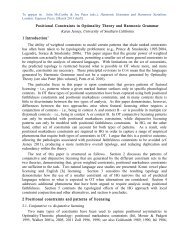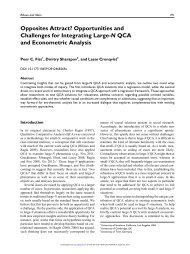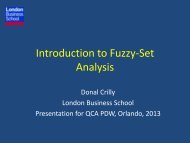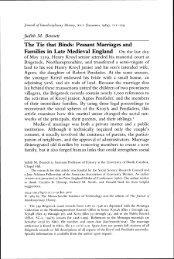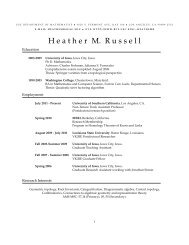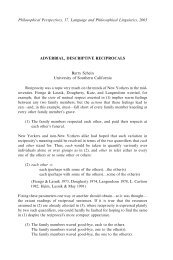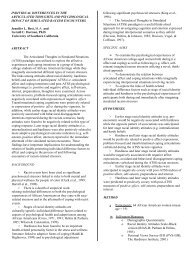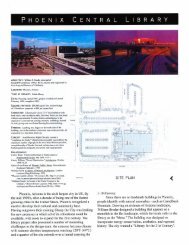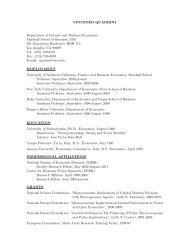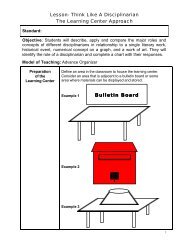Shieva Kleinschmidt [This version differs from the Phil Studies ... - Usc
Shieva Kleinschmidt [This version differs from the Phil Studies ... - Usc
Shieva Kleinschmidt [This version differs from the Phil Studies ... - Usc
Create successful ePaper yourself
Turn your PDF publications into a flip-book with our unique Google optimized e-Paper software.
description doesn’t help us gain a deeper understanding of what stuff is. In order for it to<br />
be helpful, we’d need accounts of <strong>the</strong> terms used (like made of). As it is, we have<br />
nothing to distinguish portions of stuff <strong>from</strong> things. After all, we haven’t been told<br />
anything to preclude things being made of things. (Many people speak of things<br />
constituting things; for example, a statue, which is a thing, can be said to be constituted<br />
by a lump of clay, which is ano<strong>the</strong>r thing.) In talking about stuff I will follow <strong>the</strong><br />
literature in stipulating that constitution is a relation between two relata, one of which is a<br />
thing, <strong>the</strong> o<strong>the</strong>r a portion of stuff (and hence not a thing). But this stipulation doesn’t<br />
illuminate <strong>the</strong> concept of stuff for us.<br />
Perhaps, to follow Ned Markosian’s example 4 , in order to get a better idea of what<br />
stuff is we should ostensively contrast it with things. Examples of things include: a<br />
table, a coffee pot, a balloon, a sidewalk, and a lump. Examples of stuff include <strong>the</strong><br />
wood of which <strong>the</strong> table is made, <strong>the</strong> coffee in <strong>the</strong> pot, <strong>the</strong> air in a balloon, <strong>the</strong> concrete of<br />
<strong>the</strong> sidewalk, and <strong>the</strong> clay that constitutes <strong>the</strong> lump. We refer to <strong>the</strong> things and stuff in<br />
different ways: we use count nouns to refer to things, and mass-nouns to refer to stuff<br />
(though Peter Simons draws a distinction between mass terms, which refer to portions of<br />
stuff, and mass nouns, which refer to stuff itself. An example of <strong>the</strong> former is ‘<strong>the</strong> water<br />
in <strong>the</strong> glass,’ an example of <strong>the</strong> latter is ‘water in <strong>the</strong> glass’). When we use mass nouns,<br />
we use phrases such as ‘much’ and ‘a little’ but not ‘many’ and ‘a few’ which are<br />
commonly used to describe things. 5 Also, when we use mass nouns, we can precede<br />
<strong>the</strong>m with <strong>the</strong> indefinite article ‘some,’ but we cannot do this with count nouns unless we<br />
make <strong>the</strong> count noun plural - and it never makes sense to make a mass noun plural. 6 I<br />
4 Markosian, 2004.<br />
5 Simons, Parts: A Study in Ontology, pp. 153-154.<br />
6 One might wonder about <strong>the</strong> statement “two coffees.” It seems that ‘coffee’ is a mass noun, but it can be<br />
made plural. However, as Peter Simons points out, ‘coffee’ is ambiguous: it can refer to stuff, or to a<br />
thing, such as a cup of coffee (Parts: A Study in Ontology, p. 154). In <strong>the</strong> former case, ‘coffee’ is a mass<br />
noun, and in <strong>the</strong> latter it is a count noun. Also, one might worry about an instance where someone says<br />
“two clays.” Again, ‘clay’ is a mass noun which has been made plural. But a statement like this would<br />
only make sense in a case like <strong>the</strong> one with <strong>the</strong> coffees, or in a case where someone is referring to two types<br />
or kinds of clay. But in that instance, <strong>the</strong> person is not really referring to <strong>the</strong> stuff, but ra<strong>the</strong>r to a kind, and<br />
thus is not using a mass noun.<br />
However, I should mention <strong>the</strong> issue of counting here: Some may believe that, because of <strong>the</strong> strangeness<br />
in saying things like “two clays”, we cannot count stuff, and thus we have a fur<strong>the</strong>r difference between<br />
stuff and things. I do not think this is so: insofar as counting merely requires distinctness of <strong>the</strong> entities<br />
being counted, we can count stuff, because we can recognise some stuff and some distinct stuff, just as we<br />
can recognise distinct things. <strong>This</strong> suggests to me that <strong>the</strong>re’d be nothing wrong with pluralizing references<br />
to stuff, and it’s merely a matter of linguistic convention that we do not do so.



